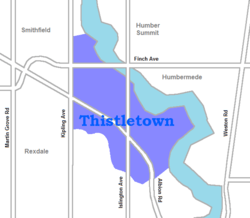Thistletown
| Thistletown | |
|---|---|
| Neighbourhood | |
|
| |
 | |
| Coordinates: 43°44′14″N 79°33′55″W / 43.73722°N 79.56528°WCoordinates: 43°44′14″N 79°33′55″W / 43.73722°N 79.56528°W | |
| Country |
|
| Province |
|
| City |
|
| Community | Etobicoke-York |
| Established | 1847 (Postal village) 'St Andrews' |
| Changed Municipality | 1998 Toronto from Etobicoke |
| Government | |
| • MP | Kirsty Duncan (Etobicoke North) |
| • MPP | Shafiq Qaadri (Etobicoke North) |
| • Councillor | Vincent Crisanti (Ward 1 Etobicoke North) |
Thistletown is a culturally diverse neighbourhood in Toronto, Ontario, Canada. It consists of the area surrounding the intersection of Albion Road and Islington Avenue in the former City of Etobicoke. (Etobicoke merged with five other municipalities and a regional government to form the new City of Toronto in 1998.)
The borders of Thistletown are generally delineated by the Humber River: the West Branch to the south, slightly beyond the river to the east, and to the William Osler Health Centre - Etobicoke General Hospital just above the river in the north. The western border is Kipling Avenue, though the part of the neighbourhood west of Islington is sometimes considered a separate area named Beaumonde Heights.
This area has seen many changes and many ethnic groups arrive and flourish. Presently the corners of Albion and Islington in Thistletown has a large presence of East Indian stores and services. They are joined by a variety of Caribbean/West Indian, Indian, Sri Lankan, and Pakistani stores. 43% of those living in this area, more specifically the CT-0250.05 are of South Asian origin, with those of Afro-Caribbean origin making up 22%.[1] One landmark is the Franklin Carmichael Art Group at 34 Riverdale Drive, located in the estate of the Group of Seven member Franklin Carmichael.
History
The village of Thistletown (originally called St Andrew's) was planned for John Grubb in 1847 around the intersection of Albion Road and Islington Avenue. The property was part of John Grubb's farmlands. Grubb was a promoter of the Albion and the Weston plank toll road companies, an elected member of the Home District Council and a magistrate. Although originally known as St. Andrew's, Thistletown was renamed in honour of Dr. William Thistle, the local physician.[2]
In 1933 Thistletown became a Police Village and 2 trustees were elected.
In the late 1950s development from the expanding city of Toronto reached Thistletown when a subdivision, Albion Gardens, was developed on local potato farm to the north and east of Albion Road.
Institutions
- Thistletown Regional Centre of Children and Adolescents
- Albion West Plaza
- Albion Gardens Park
- Beaumonde Heights Park
- Kipling Heights Park
- Churches
- Our Saviour Lutheran Church (1957)
- Thistletown Baptist Church
- Fellowship (2012 merger of Albion Gardens and Pine Ridge) Presbyterian Church
- St Andrews Roman Catholic Church
Schools
- Thistletown Collegiate Institute
- Braeburn Junior School
- St Andrews Catholic Elementary School[3]
- St John Vianney Catholic Elementary School[4]
- Beaumonde Heights Junior Middle School
- École élémentaire catholique Saint-Noël-Chabanel
See also
- Joseph Rowntree, early settler and mill-owner
References
- ↑ "Total population showing visible minority population characteristics for census tract 0250%2E05". www12.statcan.ca. Retrieved 2016-04-08.
- ↑ "Trails". Ontariotrails.on.ca. Retrieved 2012-02-02.
- ↑ "St. Andrew Catholic School". Tcdsb.org. Retrieved 2012-02-02.
- ↑ "St. John Vianney Catholic School". Tcdsb.org. Retrieved 2012-02-02.
 |
Humber Summit (North York) |  | ||
| Smithfield | |
Humbermede (North York) | ||
| ||||
| | ||||
| The Elms |